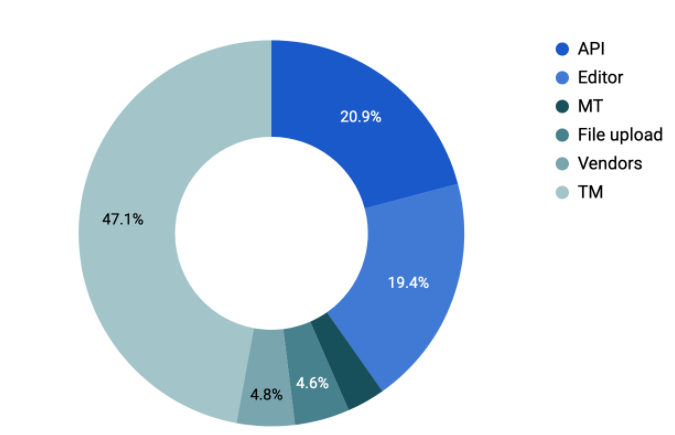

The Importance of a TMS – A Deeper Insight
Highlighting the value and importance of a Translation Management System (TMS) for localization to the rest of your organization is usually a difficult task. There are many resources and data on the value of localization. But what’s missing are some strong points on the benefits that a TMS is bringing to the table.
We recently ran an anonymous analysis on how our customers are utilizing Transifex, and the data shows that:
- Your already translated content is contributing to 47% of all translations
- Using automation tools that TMSs offer is assisting 20% more to translations
- The TMS online translation environment (CAT tool) is supporting an additional 19% of translations
- MT services are gaining more trust on serving new translations by 4%
Keep reading to learn more about the importance that a Translation Management System brings to the table.
❤️ of Analysis: Translation Data
To get an educated view of how translations are performed, we turned to data from our own platform. We were interested in the different ways that people localized their content using the platform. Possible ways include:
- Through the API to send translations to the Transifex TMS. These translations are done in tools outside Transifex either using external editors or through integrations, like the Zendesk Integration.
- Using pre-existing translations, stored in the Translation Memory. This functionality is called TM fill-up and is translating content only if the original strings/source strings, are a 100% match
- Using other services to perform the translations, like Vendors or Machine Translation (MT) services
- Uploading translation files, which means that an external non-automated service has provided the translations.
To ensure that we will analyze modern ways of localization, we narrowed the sample to translations done in the last 30 days. Data security and anonymization are really important for Transifex, so all data is aggregated and anonymized, purely focused on the volume of ways that translations are performed.
Data analysis
As shared above, we focused on aggregated anonymized data to highlight the volumes of translation types. In terms of volume, Transifex processed 7,46M translations in 30 days.
The breakdown of the aggregated data is shown in the pie chart below.
While a huge chunk of translations is done with either the editor or API, what’s interesting is that Translation Memory is leading by a huge margin. 47.1% is more than twice than the second most used tool – which just goes to show how much of a difference software tools can make. The second most common method to add translations is through the API, with 20.9% of translations being added that way.
The third method is through the Editor with 19.4%. This refers to translators using our editor to get translations done by any means, be it with the old-fashioned way or by also taking advantage of our tools.
Since the Translation Memory (TM) is populated by previous company translations, the aggregated leverage of pre-existing translations is responsible for almost half of the new translation! Owning the Translation Memory and using it correctly a company can get benefits like:
- Translations fill-up for new content that is matching to the content that is already in the TM. This fill-up can be set up to work automatically and near real-time in Transifex and – as seen above – account for half of your new translation needs. The only cost added here is the one for your TMS service – no translators or vendors are needed.
- Use previous translations as a guiding point for the work that translators do in the Editor – which is also heavily used for translations. The TM is available in the Transifex Editor through the Suggestion tab and the Concordance functionality.
Moving on to API usage for translations, we can clearly see the need for automation in the localization process. API usage entails integrations, as the integrations are leveraging API calls to exchange data.
Essentially, this means that certain development is needed in order to properly set up automation and leave it to play on its own, without a need for hands-on intervention. A safe assumption reading the data is that 20% of the translations are automated through tools that the Transifex TMS is offering.
The quality and effectiveness of the provided tools is a critical factor in Editor usage, as translators and reviewers are interested in providing precise translations faster.
The alternative to using the Editor for translations is to use another CAT tool and upload a file with the translations.
Checking the graph above, we can see the respecting field to be sixth in terms of preference for translation, that is File Upload with 4.6% of new translations. An assumption here is that people using Transifex trust the provided Editor tools almost four times more than an external editor.
About Vendors and Machine Translation
The Vendors metric is reflecting how many companies have used the Order wizard to get translations for their content – that is 4.8% of all translations. By ordering translations, you send your content as a file to a vendor for them to handle all of the localization work for you.
This percentage is reflecting the shift that is currently happening towards a more continuous localization workflow, that can not be represented through ordered translations.
What’s happening instead is translation vendors (LSPs) and companies entering a Master Service Agreement (MSA), where the relation is continuous.
Finally, Machine Translation (MT) contributes 3.2% of all translations. Despite being small, this percentage is comparable to the rest of the translation sources. This presence reflects an increased trust in MT as a translation option with fair quality.
You can find more about Vendors and Machine Translation, and how those will be affecting localization workflow in the future by checking out the highlights from our latest webinar with Quora, Localization Strategy and Workflow.
Conclusion
Combining all the above metrics and data – as those are reflecting actual TMS usage – we can clearly see how Transifex is contributing to at least 88% of the new translations performed either via TM, or API and automation, or the Editor.
The greatest importance of a TMS is that of the glue required to gather and control all your content that needs localization. Whether you are using an Integration, the provided Editor, an API, or even a Vendor of choice, a TMS is standing in the center of it all making content available within and across – with tools like Translation Memory – saving you time and money.









